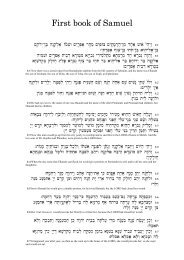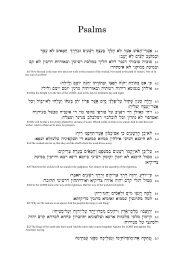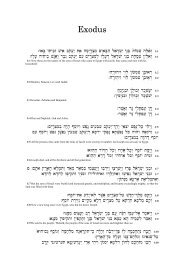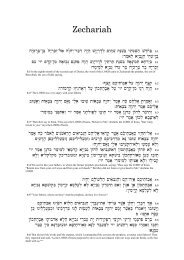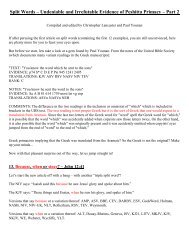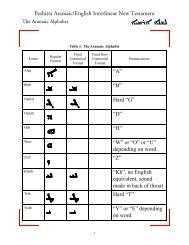ana translation
Untitled - Peshitta Aramaic/English Interlinear New Testament
Untitled - Peshitta Aramaic/English Interlinear New Testament
- No tags were found...
You also want an ePaper? Increase the reach of your titles
YUMPU automatically turns print PDFs into web optimized ePapers that Google loves.
Ixxii<br />
INTRODUCTION<br />
This eighth Book and those that follow are the work of<br />
a continuator,<br />
and were completed in A.D. 569. He tells us that it " was found [i.e.,<br />
apparently, the Greek of it] in the Gospel of "<br />
Mara, Bishop of Amid<br />
[died circ. 527].<br />
Whether Mara, or this continuator, or some other,<br />
translated it into Syriac, is uncertain. It seems to be extant neither<br />
in Greek nor any other language. This Syriac version of the story in<br />
this form belongs (as the date of the eighth Book above given proves)<br />
to the sixth century,* and is earlier by nearly half a century than the<br />
better known version by Paul of the story in its familiar form. Both<br />
forms (it<br />
is to be noted) claim to have been " found " by Syrian<br />
ecclesiastics at Alexandria, j<br />
3. Below (p. 46) I have referred to a version of the Paul-form of the<br />
Pericope, appended to a very recent copy of the Gospels (Bodl. Or.<br />
625) bearing date 1801, the work of a Malabar scribe, which I have<br />
forborne to print, judging from internal evidence that it was merely a<br />
<strong>translation</strong> from the Latin Vulgate probably connected with the action<br />
of the Synod of Diamper. I have found, since p. 46 was written,<br />
that in Deer. 2, cap. xiv of Actio in of that Synod, A.D. 1599, after<br />
noting the defects of the Peshitta Bible, the Synod orders that they<br />
are to be supplied<br />
" according to the Chaldee copies which are emended<br />
and the Vulgate Latin Edition " ;<br />
and that this is to be done by Francisco<br />
Roz, a Jesuit, Professor of Syriac in the Jesuits' College at Vaipicotta,<br />
founded a few years previously (see Geddes, Hist, of Malabar<br />
Church, as cited above, p. xlv, note f).<br />
To him, therefore, we may without<br />
hesitation attribute this <strong>translation</strong> of the Pericope. But there seems<br />
to be no evidence that he fulfilled the directions of the Synod by translating<br />
also our Four Epistles. Possibly the version of the Revelation,<br />
of which two copies are among Dr. Buch<strong>ana</strong>n's Malabar Syriac MSS<br />
be the work of the same<br />
in Cambridge University Library, J may<br />
translator.<br />
* The MS h (Br. M., Add. 17202), which contains the Chronicle, is probably to<br />
be dated not later than A.D. 600.<br />
t For Zacharias, see Land, Anecdota Syr., t. in, Introduction ;<br />
also that of<br />
Mr. Brooks (above mentioned)<br />
: for Mara, Land (as before), pp. 245, 250 (v.<br />
and<br />
vii. of Chronicle, Book vni)<br />
: for both, Assemani, B.O., t. ii, pp. 52, 54.<br />
I CataL, Oo. 1, 11 (7) ;<br />
Oo. 1, 21. Whether the Syriac version of the Eevelation<br />
(with Commentary), of the same Library, Add. 1970, is identical with the above,<br />
I have not ascertained. It professes to be translated from an Arabic <strong>translation</strong><br />
from the Latin. All these MSS are Nestorian, of the eighteenth century.



